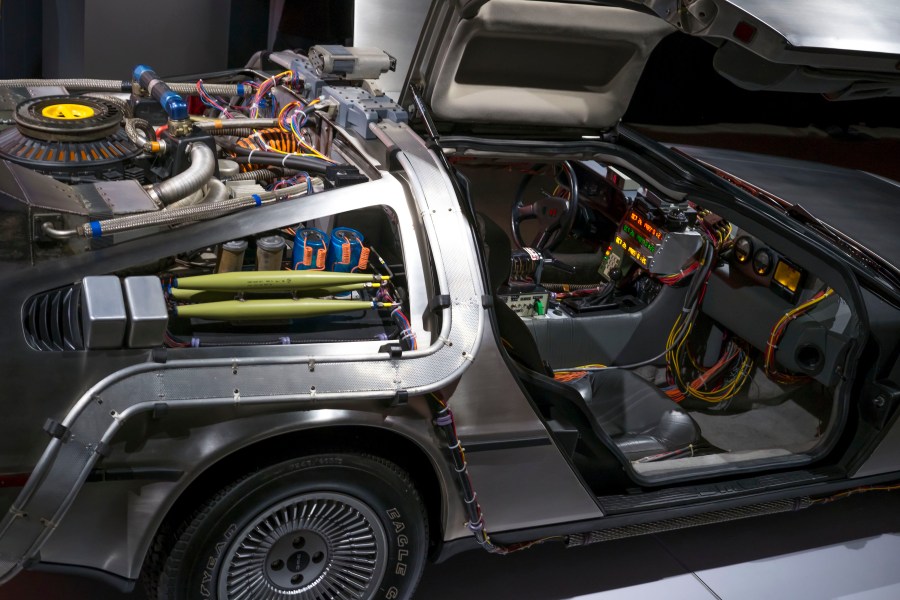“Hollywood Dream Machines” exhibit explores sci-fi vehicles used on screen

The future of cars is always exciting and always just around the corner. Things like self-driving cars have been five years away for, oh, about 40 years now. But there are times when pure imagination is exactly what’s needed, when vehicles have to be as out there as possible. Nearly incredible cars are a big part of science fiction TV shows and movies. They’re often characters themselves, and someone has to make them.
Marketplace’s Jack Stewart went to see some of the creations of writers, directors and designers at a new exhibition at the Petersen Automotive Museum in Los Angeles. It’s called “Hollywood Dream Machines,” and there are cars from “Mad Max,” “Blade Runner” and the classic “Star Wars,” among others. Bryan Stevens, exhibitions and creative director at the museum, started by explaining how car designers might work with filmmakers. The following is an edited transcript of their conversation.
Bryan Stevens: In the use of vehicles in Hollywood productions, there are a number of scenarios, [only] one of which is the need to design a car from scratch to fulfill the vision of the producers or the directors of the film. In many cases there are pre-existing cars that do just that, and there’s no need to design a car from scratch. When it came time to create “Back to the Future,” it just so happened that this very exotic, wild, stainless steel-bodied car existed [the DeLorean]. In fact, it was very much in the public eye due to some lawsuits at the time, which made it a perfect option for this particular use in this particular film.
Jack Stewart: Now that we are up close, I can see there are a lot of wires, zip ties, parts that look almost unfinished.

Stevens: Yes, which is deliberate. In this case, the producers and directors of the film didn’t want something polished. They wanted something that looked like it was handmade in a garage.
“I think there’s no question that when today’s designers were children watching these television shows and these movies, that they are even potentially subconsciously gaining inspiration from what they see.”
Bryan Stevens
Stewart: You worked with the designers of some of these cars to actually put this exhibit together. How important did they say it is to be accurate as opposed to just entertaining when they’re coming up with these visions of the future?
Stevens: I think it’s a combination of both. If you’re projecting 50 years in the future, I think accuracy is going to be difficult to achieve regardless of what you propose. But they certainly do want some level of realism. When you start getting into science fiction films, as opposed to pure fantasy films, you do want there to be an element of science basis. You want there to be something that seems even somewhat plausible about what you’re predicting.

Stewart: You have KITT here, for example, from “Knight Rider” from the ’80s. Do you think a vehicle like that, that was fully autonomous long before most of us had heard of even the concept of self-driving cars, are cars like that an inspiration to real engineers and real designers?
Stevens: I think there’s no question that when today’s designers were children watching these television shows and these movies, that they are even potentially subconsciously gaining inspiration from what they see. That’s probably part of why we see some of the technologies that are shown in these vehicles eventually become real.
Related links: more insight from Jack Stewart
Check out the exhibition website if you want some inspiration for movies to binge on this holiday. I’d forgotten how much I enjoyed some of them. The Audi RSQ concept from “I, Robot” made me want to watch that again, and I’ll be streaming the original “Blade Runner,” as well as “2049,” to see that vision of Los Angeles with spinners in the dark and rainy skies. Fun fact: In early drafts of the “Back to the Future” script, the time machine was built into a refrigerator, not a car. What a different movie that would have been.
In terms of making these sci-fi visions come alive, the Atlantic has a great story with the headline “Flying Cars Are Real, and They’re Not Bad for the Climate.” It describes the efforts to build a new type of electric flying machine that isn’t a plane, isn’t a helicopter, but could fly, building top to building top, skipping city traffic.
It’s not just frustrated commuters who could benefit. As sea levels rise, coastal cities like Miami are going to have to go to ever-greater lengths to mitigate the impacts of climate change. A Quartz story looks at developers in Miami who are already designing buildings where rooftop observation decks can be converted into flying taxi ports. (Where we’re going, maybe we really won’t need roads!)
Also, if you didn’t catch it on the air, check out our recent Marketplace Tech series on climate change adaptation, “How We Survive.”
The future of this podcast starts with you.
Every day, the “Marketplace Tech” team demystifies the digital economy with stories that explore more than just Big Tech. We’re committed to covering topics that matter to you and the world around us, diving deep into how technology intersects with climate change, inequity, and disinformation.
As part of a nonprofit newsroom, we’re counting on listeners like you to keep this public service paywall-free and available to all.
Support “Marketplace Tech” in any amount today and become a partner in our mission.












